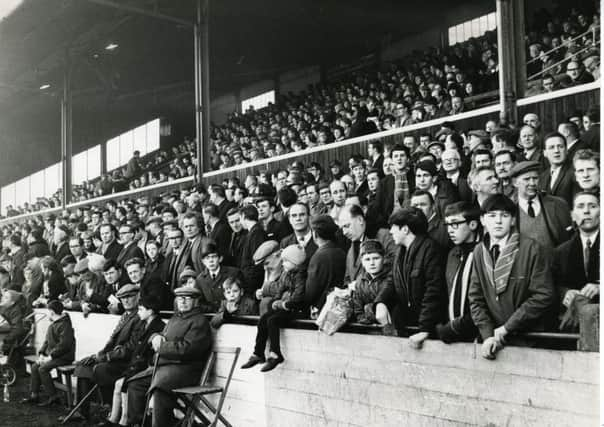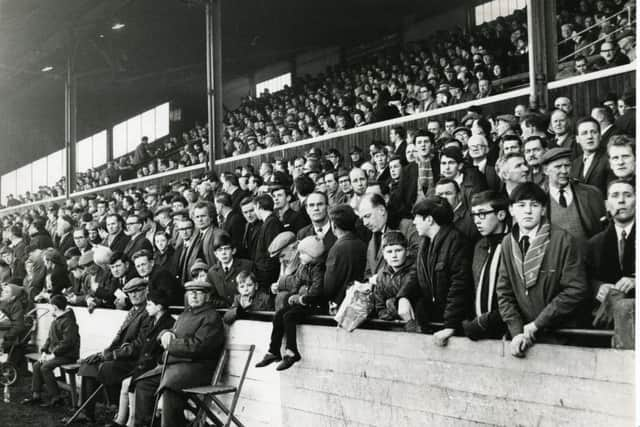Aidan Smith: Photographs from bygone era captured football at its best


It’s a stunning shot but I think I’ve just seen a better one. This is the cantilevered stand at Dundee United’s Tannadice, the first such structure in Britain to bend round a corner. But it’s only half-finished. The seats are in place but not much else. For instance, where are the stairs and how did the fans access the new vantage-point if it wasn’t with ropes or perhaps some levitation? As Steve Finan says in his book Lifted Over the Turnstiles, where you’ll find the image, Health & Safety wasn’t such a big deal at the dawn of the 1960s.
I say they’re fans but they don’t look like fans, at least not in the modern sense. They’re mostly men and nearly all of them are wearing a long and substantial overcoat, a flat cap and a tie. They look like members of the local Temperance Society and you can imagine that all through the match they were models of restraint and decorum, perhaps puffing slightly more enthusiastically on their pipes during the penalty-box stramashes.
Advertisement
Hide AdAdvertisement
Hide AdWhat has become of us? How has the football supporter turned into someone who might shout racist or anti-Semitic hate, or taunt a player bravely battling visual impairment by throwing joke shop eyeballs at him?


Why does the fan abuse an opposition player over the colour of his skin when his own team contains black players? Why does the fan then carry right on down the road to Bonkersdom by turning on a member of the side he allegedly follows, spitting vicious words which also reference the fact he’s black?
You will have to ponder these questions long and hard. You might say to society: we can see you sneaking out, it’s your problem, too. You might say to David Cameron: all this division and bitterness is partly your doing thanks to Brexit – we hope the roof blows off your posh man-cave at the bottom of the garden and that you never get those memoirs finished, requiring you to hand back that whopping £800,000 advance.
And if you were to seek solace in the past and how things used to be at football matches, who could blame you? Not me.
In 1961 when that Tannadice stand was built, society was still society, it wasn’t yet the permissive society. The Beatles hadn’t released their first LP. Your mum and dad weren’t f*****g you up. There was respect and there was deference. Footballers weren’t earning big money, causing a disconnect with the supporters; they were modest guys putting in a Saturday afternoon shift of honest and honourable graft and many of those watching would have completed a Saturday morning shift at their factories and workplaces before heading down to the match.
The war wasn’t so many years before and the fans were still grateful for having the people’s game returned to them. They demonstrated this by filling the grounds. Lifted Over the Turnstiles is full of photos of sardine-squash congregations such as the one for a Morton-Dundee encounter at Cappielow. There’s a vivid contrast between these jam-packed ends and the completely deserted stand which jarred the eyes in Friday night’s televised game between Livingston and Hearts.
Some of the images in the book haven’t been seen for 60 years and many are corkers. The grounds are the unwitting stars. Newspaper snappers wouldn’t have given much thought to stanchions, corrugated roofs, floodlight pylons, dog-tracks, bays for wee blue disability three-wheelers, and bespoke, quirky, beautiful-to-behold grandstands when they were concentrating on the action on the park – but background becomes foreground in Finan’s collection, and younger supporters who suspect that their breeze-block arena is pretty similar to many others around Scotland will study these photos and weep.
The most poignant shots are of the grounds that are no longer with us. My life will always feel a tiny bit incomplete because I couldn’t get round them all in time. For instance: Dumbarton’s Boghead, surely the finest and most evocative name for a stadium there has ever been. Yes, I’ve been blessed with four children, but I never saw my team play there. But I did witness a game at Clydebank’s Kilbowie, although tragically not in 1967, the apogee of Swinging London, when, not to be outdone, those wheeze-merchant brothers Jack and Charlie Steedman stuck tables and parasols at the top of the terracing, the umbrellas promoting Dubonnet over Bovril.
Advertisement
Hide AdAdvertisement
Hide AdWhen I look at the photos of Third Lanark’s Cathkin Park I’m reminded of Arthur Montford, pictured, telling me that the commentary position down by a corner was the most challenging in all football, especially on pea-souper days. The shots of Brockville show the part of the main terracing where Kevin McAllister stood as a boy, before becoming a Bairns legend. Crunchie told me that 13 years after the ground was knocked down he still couldn’t visit the Morrisons which had been built in its place, preferring to take a long detour to a branch in Stirling.
Another colosseum supplanted by a supermarket was Muirton Park. There’s a snap in the book from 1969 with kids peering over the terrace wall and grandads parked on folding chairs. Ties are still de rigeur and yet two years later, I learned from Stuart Cosgrove, St Johnstone and Dundee fans chose a Christmas Day derby to have a mass pagger with the future broadcasting impresario escaping the bovver by leaping over a garden wall and into a front room while the turkey was being carved.
Everyone is on good behaviour in these marvellous images, though, and only the Montrose polis keeping a wary eye on some Links Park toerags hints at the hooliganism that was to come in the 1970s and, we suspect now, may not have gone away but was simply lying dormant. Really, the photographers did not know it as they wiped the mud and soot off their lenses, but they were capturing football at its best.